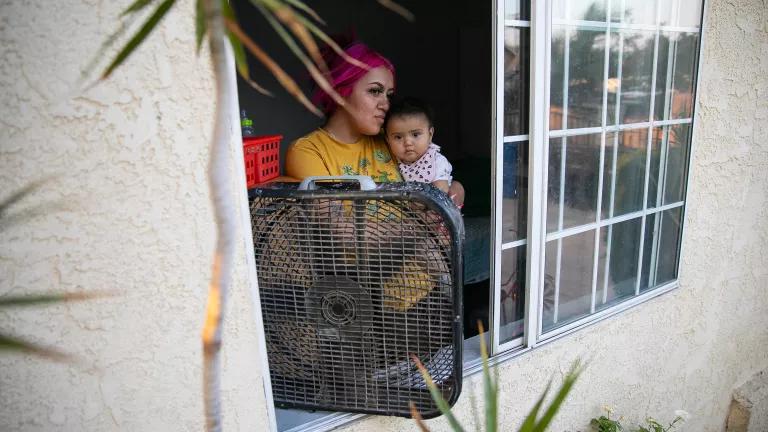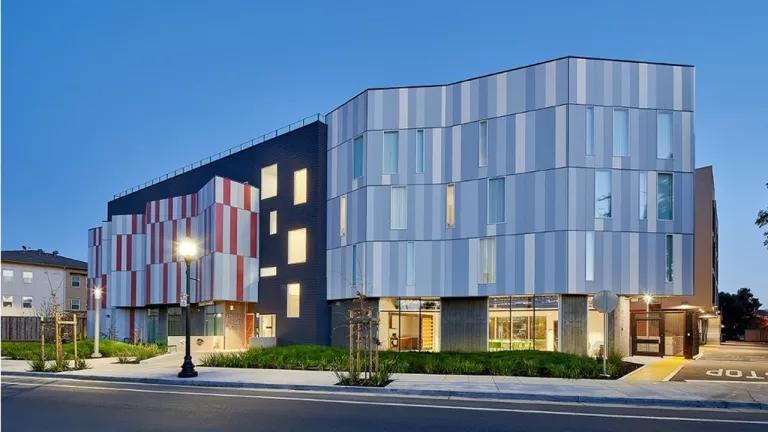New Brief: Creating Healthy Resilient Homes & Reducing GHGs
Equitable building decarbonization works to resolve mistakes of the past and creates a way to move forward to a livable planet.

Karen Tapia cools off her daughter Jessalyn by a window with fan running on high because her home does not have A/C during a heatwave on Wednesday, Sept. 7, 2022 in Los Angeles, California.
Jason Armond / Los Angeles Times via Getty Images
This blog is co-authored by Edgar Barraza, Energy Equity Policy Coordinator at Physicians for Social Responsibility- Los Angeles (PSR-LA) and member of the Building Energy Equity and Power coalition (BEEP) - an environmental justice lead group which focuses on equitable building decarbonization issues at the state level. NRDC supported the equitable building decarbonization expertise and leadership of the BEEP coalition in the creation of this issue brief.
State and local leaders across California have made it clear - building decarbonization is critical for reaching our ambitious carbon reduction goals. However, if done inequitably, building decarbonization programs and policies can lead to unintended negative consequences for renters, communities of color, and low-income communities. This, in turn, often derails greenhouse gas (GHG) reduction efforts. Thus, adopting an equity-driven approach to home upgrades is crucial to minimize unintended consequences, maximize benefits to low-income and communities of color, and ultimately reach our carbon reduction goals. In a new issue brief, Centering Housing Justice and Health Equity in Building Decarbonization, we examine the housing quality inequities faced by low-income communities and communities of color. Additionally, we explore how equitable building decarbonization, especially when co-designed with environmental justice organizations, has the capacity to rectify these inequities.
According to the California Air Resources Board (CARB), buildings account for about 25 percent of California’s GHG emissions. In response to this, CARB initiated a building appliance standard rulemaking that will phase out the sale of gas heaters. The rulemaking is scheduled for 2026. In a parallel process, the California Energy Commission is developing the Equitable Building Decarbonization program that will prioritize the decarbonization of low-income homes in environmental justice communities. Although these initiatives mean to do good by reducing greenhouse gas emissions, there is a need for caution. These policies and programs may have unintended consequences if they are inaccessible and if adequate tenant protections are not in place. Such safeguards are crucial to protect vulnerable communities from being permanently evicted through the guise of the renovation and installation of all electric appliances.
As the brief explains, many housing quality inequities in the U.S. are rooted in decades of racist housing policies, including redlining, residential segregation, racial housing covenants, and exclusionary zoning practices. These policies created substantial barriers for people of color to purchase property, live in resilient and healthy homes, or accumulate generational wealth. In addition, established communities of color often faced neglect and disinvestment. In the present day, this legacy has manifested as significant disparities in both health and wealth between communities of color and white communities.
High and severe energy burdens, or when a household spends more than 6 or 10 percent of income on home energy bills, disproportionately affect communities of color. This is partially attributed to structural deficiencies and inefficient appliances in the home due to persistent historical disinvestment. Government-administered home upgrade programs are intended to solve this issue but often miss the mark through flawed program design and implementation. As a result, low-income households, multifamily residents, and communities of color frequently miss out on upgrades that would greatly improve housing quality. Energy inefficiency alone has negative health impacts (such as a lack of financial resources to heat or cool the home in extreme weather events, having to decide between paying for energy and critical needs like medicine or healthy foods).The report details four examples where there is well-established evidence that poorer housing quality contributes to racial disparities seen in particular health conditions: respiratory issues like asthma and allergies, heat-related impacts such as stroke, mental health concerns, and lead-related impacts such as brain and nervous system damage.
Building decarbonization measures present a unique opportunity to both reduce carbon emissions and significantly improve affordability and public health, given proper design and implementation of policies and programs. Weatherization, for instance, can improve asthma and allergy outcomes by reducing the infiltration of outdoor air pollutants and providing better thermal and humidity control. Holistic home improvements, such as mold, pests, lead paint, and asbestos, can further limit or eliminate harmful exposure to health threats. Additionally, building electrification has the potential to improve indoor and outdoor air quality, particularly in disadvantaged communities, as indicated by modeling for California. When electrification is paired with energy efficiency, residents can benefit from reduced utility bills and more comfortable indoor temperatures. If on-site renewable power generation and storage are included, residents can further reduce bills, clean the grid, and keep the lights on in a power outage during severe weather events.
With policies and programs focused on building decarbonization on the rise, it’s critical to ensure equity is centered in program design. Building decarbonization policy must also be leveraged to address long-standing housing quality, energy, and health issues, maximizing beneficial outcomes for low-income communities and communities of color. To accomplish this, this brief recommends that:
- Building decarbonization program design encompasses health, affordability, and energy efficiency;
- Public investments are directed to and benefit communities facing the greatest housing and health disparities;
- Impacted communities have leadership and engagement in the design, implementation, and evaluation of building decarbonization programs and policies; and
- State and local government coordination to create robust, accessible programs and develop policies targeted to address root causes of racial, housing, wealth, and health disparities.
Equitable building decarbonization works to resolve mistakes of the past and creates a way to move forward to a livable planet. This presents a much-needed opportunity to create healthy, resilient homes for everyone and begin bridging the racial, housing, wealth, and health disparities gap.
Issue Brief: Centering Housing Justice and Health Equity in Building Decarbonization was co-authored by Kate Connolly (Columbia University), Edgar Barraza (PSR-LA), Antonio Diaz (PODER), Sabrina Johnson (NRDC), Olivia Seideman (LCJA), Christine Selig (PODER), Veena Singla (NRDC), Katie Valenzuela (CVAQ), Sooji Yang (Common Spark Consulting), and prepared for the BEEP coalition, composed of LCJA, CVAQ, LCEA, PODER, PSR-LA, SHE, and CRPE.
Edgar Barraza is the Energy Equity Policy Coordinator at Physicians for Social Responsibility - Los Angeles. The majority of his efforts are dedicated to supporting the BEEP coalition on California state policy. His work is grounded in the community through the newly formed coalition Los Angeles for Resilient and Healthy Homes which is also devoted to developing community centered building decarbonization policy with the City of Los Angeles.




